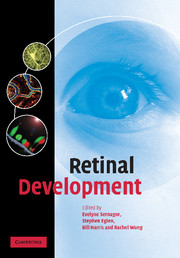Book contents
- Frontmatter
- Contents
- List of contributors
- Foreword
- Preface
- Acknowledgements
- 1 Introduction – from eye field to eyesight
- 2 Formation of the eye field
- 3 Retinal neurogenesis
- 4 Cell migration
- 5 Cell determination
- 6 Neurotransmitters and neurotrophins
- 7 Comparison of development of the primate fovea centralis with peripheral retina
- 8 Optic nerve formation
- 9 Glial cells in the developing retina
- 10 Retinal mosaics
- 11 Programmed cell death
- 12 Dendritic growth
- 13 Synaptogenesis and early neural activity
- 14 Emergence of light responses
- New perspectives
- Index
- Plate section
- References
9 - Glial cells in the developing retina
Published online by Cambridge University Press: 22 August 2009
- Frontmatter
- Contents
- List of contributors
- Foreword
- Preface
- Acknowledgements
- 1 Introduction – from eye field to eyesight
- 2 Formation of the eye field
- 3 Retinal neurogenesis
- 4 Cell migration
- 5 Cell determination
- 6 Neurotransmitters and neurotrophins
- 7 Comparison of development of the primate fovea centralis with peripheral retina
- 8 Optic nerve formation
- 9 Glial cells in the developing retina
- 10 Retinal mosaics
- 11 Programmed cell death
- 12 Dendritic growth
- 13 Synaptogenesis and early neural activity
- 14 Emergence of light responses
- New perspectives
- Index
- Plate section
- References
Summary
Introduction
Müller cells, the principal glia of vertebrate retinas, are radial glia that span the entire depth of the retina. The distal processes of Müller cells form the external limiting membrane of the retina, while their ‘endfeet’ form the inner limiting membrane. Müller cell processes surround neuronal cell bodies in the nuclear layers and contact synapses in the plexiform layers (Newman and Reichenbach, 1996). Müller cells play a major role in regulating extracellular K+ and pH (Newman et al., 1984; Karwoski et al., 1989; Kusaka and Puro, 1997), in neurotransmitter uptake (Pow, 2001) and in glutamine synthesis (Riepe, 1977, 1978; Germer et al., 1997a; Prada et al., 1998), functions performed by astrocytes in other regions of the central nervous system. Müller cells also have some similarities to oligodendrocytes; although they do not form myelin, Müller cell processes wrap the axons of retinal ganglion cells (Holländer et al., 1991; Stone et al., 1995). In addition, intercellular Ca2+ waves have been observed among Müller cells (Newman and Zahs, 1997). These waves are increases in glial cytosolic Ca2+ that propagate away from the site of initial activation. The arrival of Ca2+ waves in retinal glia is correlated with modulation of the light-evoked activity of neighbouring retinal ganglion cells (Newman and Zahs, 1998). Modulation of retinal ganglion cell activity has been shown to be mediated by a variety of factors released by Müller cells, including purine nucleotides (Newman, 2003) and d-serine, a co-agonist at the N-methyl-d–aspartate (NMDA) type of glutamate receptor (Stevens et al., 2003).
- Type
- Chapter
- Information
- Retinal Development , pp. 172 - 192Publisher: Cambridge University PressPrint publication year: 2006



